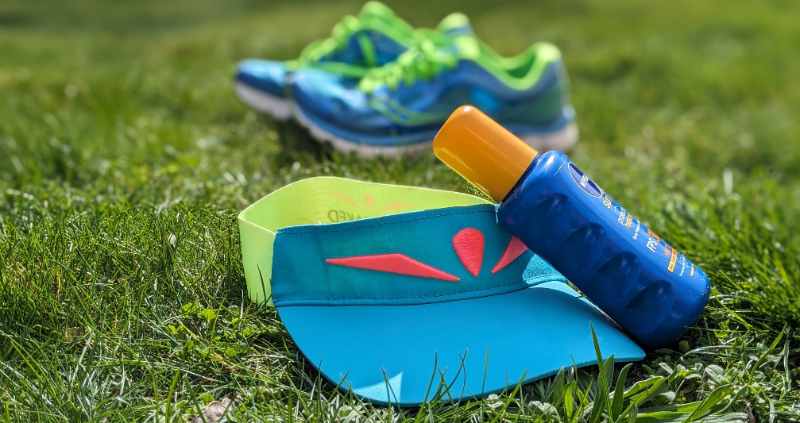Running Jargon

Running jargon can be a whole new language and to the uninitiated it can be quite intimidating.
When I first started running, my running jargon consisted of "run, stop, exhausted, hard, tired" and so on. Then when I joined a running club, I was suddenly faced with phrases such as, "What is your cadence?" or "Let's do fartleks".
Fart what?
What the heck were they talking about? It felt a bit like when you walk into the wrong class by accident.
So for the running newbies, here are a few useful running terms to help you out.
Running Jargon Vocab
Aerobic Running:
When your run slow and easy, your body is able to use its available oxygen through respiration to to give you energy. This is known as aerobic running.
Aid Station:
Also known as a water stop or ravitaillement ( here in France). It is a planned point along a race course where people will be handing out water, sports drinks and food snacks for the runners to rehydrate and to stock up on energy.
Anaerobic Running:
When running hard and fast, the oxygen that you are breathing in is usually not enough to cope with the energy demands of your body. This is known as anaerobic running.
----- Running Jargon -----
Bandit:
Someone who has joined in on a race illegally i.e. they haven't paid the entrance fee or got the official right to participate.
Base Mileage:
The average amount of miles a runner runs per week before starting a specific training program.
Bib:
The paper with your race number that you pin to your running shirt or shorts.
Black Toenails:
Not the painted type but when your toenail turns black. It's caused by trauma to your toenail usually from banging your toe against the front of your shoe whilst running. Find out how to prevent black toenails.
Bonk:
This is also called "Hitting the Wall" and it occurs when your body has run out of glycogen (sugar) and you literally have no more energy supplies in your body. You will often hear about people bonking in a marathon.
BPM:
This stands for beats per minute and refers to your heart rate.
BQ:
This stands for Boston Qualifier and means that someone has run a marathon in a particular time that allows them to enter the ballot for the Boston Marathon. Each age group, male and female, has a specific qualifying time.
Burnout:
Over trained and exhausted.
----- Running Jargon -----
Cadence:
The number of steps taken per minute whilst running.
Carb Loading:
You'll often hear people talking about this just before a marathon or long endurance event. It means loading your body with lots of carbohydrate foods just before a race so that your muscles and liver stores are high in glycogen. Your body uses the glycogen during the race to provide energy.
Chip:
Computer timing chip (provided by the course organizers) which is attached to your shoe. It records your running time as you cross certain points on the course. There are usually timing mats on the ground which register your chip as you pass over them.
Chip Time:
During large races it can take several minutes from the start whistle to when you cross the actual start line. Your chip time is the time recorded (via your chip) from when you cross the start mat to when you cross the finish mat.
Corral:
Before a big race such as a marathon and especially where there are thousands of runners, the runners are divided into groups depending on their planned finish times. Each group is assigned a corral which is a designated area at the lineup for the start of the race.
Cross Training:
Training other than running such as swimming, weights, cycling.
----- Running Jargon -----
DNF:
Stands for "Did Not Finish". You will see this in race results.
DOMS:
Stands for "Delayed Onset Muscle Soreness". It is a muscle soreness that peaks around 48 hours after a hard run.
Dynamic Stretching:
Active movements of your muscles but which don't end in with you holding them in a stretched position for a period of time. Examples are squats, lunges or leg swings.
----- Running Jargon -----
Easy Run:
A run done at an easy pace whereby you could comfortably chat away to your running buddy.
Fartlek:
This term originated from Sweden and means "speed play". It basically means varying your pace between jogging and sprinting during a run. You choose the pace and the length as it suits you.
Foot Strike:
How your foot hits the ground when running. You also might hear the terms toe strike, heel strike or mid foot strike.
Fuel:
The food and fluids that you might consume during a run or race.
----- Running Jargon -----
Gait:
Your running style taking into account how your hips, knees and feet work together.
Glycogen:
Sugar stored in your body, namely in the liver and muscles, is known as glycogen. Your body uses this glycogen to help fuel your run.
GU:
The unofficial term that runners use for energy gels.
----- Running Jargon -----
Hill Repeats:
This is a workout whereby you sprint up a hill and jog or walk back down to recover. The you repeat the process for a set number of times depending on your training plan.
Hitting the Wall:
This is also known as bonking. It occurs when your body has run out of glycogen (sugar) and you literally have no more energy supplies in your body. You will often hear about people hitting the wall in a marathon.
----- Running Jargon -----
Ice Bath:
Runners might take an ice bath after a particularly hard or long race or training run. It involves immersing your legs or sitting in a bath filled with cold water and lots of ice cubes for around 15 minutes. Ice baths constrict blood vessels so help to reduce swelling. Once you get out of the bath, blood rushes to your legs to warm them up and this helps flush any waste products out of the cells.
Intervals /Interval Training:
A workout (usually on a track) which involves a segment of fast running followed by a recovery period ranging from seconds to minutes. The number of intervals, speed and distance depends on your training plan.
ITBS:
This stands for Illiotibial Band Syndrome. It is a running injury whereby the illiotibial band (band of connective tissue running from the outer side of your thigh to your knee), becomes tight and inflamed.
----- Running Jargon -----
Joggers Nipples:
When your nipples bleed due to continuous rubbing against your running top. It affects men much more than women as women are more protected by a running bra.
Lactate Threshold:
When you run, your body breaks down glucose for energy, a byproduct of this process is lactate acid. With easy running, the lactate acid is recycled and converted back to energy or expelled. However the faster or longer you run, the more lactate you produce and there comes a point where your body can no longer handle this high level of lactate and this causes you to fatigue. This point is known as your lactate threshold.
Long Slow Distance Run / Long Run:
A long run is often done once a week and is basically a run that is longer than your usual runs during the rest of the week. It is done at an easy steady pace in order to help build endurance and to get you used to time on your feet.
----- Running Jargon -----
Masters:
Masters is the US term for a runner generally over the age of 40. In other countries you might be referred to as a 'Veteran'. Masters are then split into further categories such as M1 (40-50), M2 (50-60), M3 (60-70) and so on. The ages might vary slightly in different countries. Which masters category are you in?
Maximum Heart Rate:
This is the maximum rate your heart can reach during your maximum physical exertion. It is usually genetically determined.
Moisture Wicking:
Moisture wicking fabrics are able to draw moisture away from the skin and to direct it to the outside of the material where it can more easily evaporate.
Negative Splits:
A split is a set distance such as a mile or km. Running negative splits in a race means that your ran the second half of a race faster than the first half.
----- Running Jargon -----
Pace:
The time it takes to complete a mile or km. 10k pace would mean the time it takes you to run a mile or km in a 10k race.
PB or PR:
PB stands for Personal Best and PR stands for Personal Record.
Plantar Fasciitis:
Inflammation on the bottom of the foot, often the heel, from irritation to the fibrous tissue. Suffering from Plantar Fasciitis?
Pronation:
Relates to how your foot strikes the ground whilst you are running. If you over-pronate, your foot rolls inwards past the standard norm and if you under-pronate, your foot rolls outwards past the standard norm.
----- Running Jargon -----
Recovery Run:
This is a run usually done the day after a hard workout or run. It should be easier than you easy run and be short and slow. The aim of it is to get the blood gently pumping through your muscles in order to flush out any waste products.
RICE:
RICE stands for Rest, Ice, Compression, Recovery. It is the usual fist aid for running injuries.
Runner's Knee:
Another name for Patellofemoral pain syndrome. It is a common running injury and gives you a dull pain around or under your knee cap. It is thought to be caused by the stress of your knee cap continually rubbing on your thigh bone.
----- Running Jargon -----
Shin Splints:
This is also known as medial tibial stress syndrome. The tell tale sign of pain along your shins might alert you to it. It is thought to be caused by low bone density in a certain area of the shin bone which reacts negatively to the stress of running.
Speed Work:
Any run that has you running at speed. This might be intervals, hill sprints or tempo runs.
Static Stretching:
Where you stretch a muscle or ligament and hold it in the stretched positon for a short period of time. Examples might be hamstring stretches or shoulder stretches.
----- Running Jargon -----
Tapering:
Before a big race such as a marathon, runners need to rest their body from training or at least greatly reduce it, so that their body has time to refuel and be on top form. This is known as tapering.
Tempo Run:
A form of speed training whereby you run at a hard but fairly comfortable pace at just below your lactate threshold. You should be able to say a few words but not much more.
Threshold Run:
A threshold run is a run at or near your threshold whether it be your aerobic, anaerobic or lactate threshold.
----- Running Jargon -----
Ultra:
Any race longer than a marathon (26.2 miles or 42.195km).
Veteran:
Veteran is the term for a runner generally over the age of 40. In the US you are referred to as a 'Masters'. Veterans are then split into further categories such as V1 (40-50), V2 (50-60), V3 (60-70) and so on. The ages might vary slightly in different countries.
VO2 Max:
V stands for volume and O2 stands for oxygen. Your VO2 max is the maximum amount of oxygen that your body can use during exercise. Your VO2 max level will depend on how efficient your heart is at pumping oxygenated blood around your body. The higher your VO2 maw, the fitter you are thought to be.



